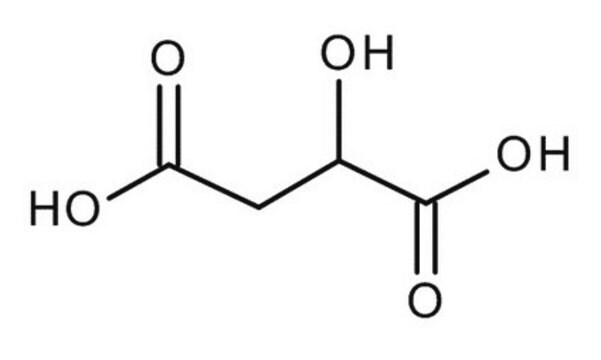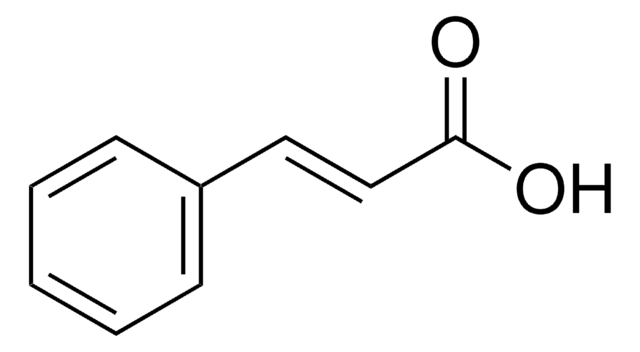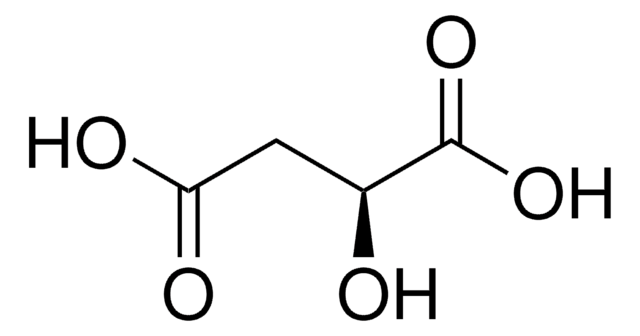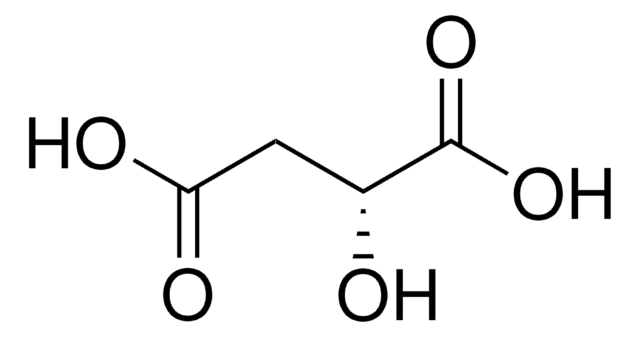W265501
DL-Malic acid
99%
Synonyme(s) :
(±)-2-Hydroxysuccinic acid, DL-Hydroxybutanedioic acid
About This Item
Produits recommandés
Source biologique
synthetic
Niveau de qualité
Qualité
Kosher
Conformité réglementaire
FDA 21 CFR 1084.1069
FDA 21 CFR 117
Densité de vapeur
4.6 (vs air)
Pression de vapeur
<0.1 mmHg ( 20 °C)
Pureté
99%
Température d'inflammation spontanée
644 °F
Pf
131-133 °C (lit.)
Solubilité
H2O: soluble 646.6 g/L at 20 °C
Application(s)
flavors and fragrances
Documentation
see Safety & Documentation for available documents
Allergène alimentaire
no known allergens
Propriétés organoleptiques
odorless
Chaîne SMILES
OC(CC(O)=O)C(O)=O
InChI
1S/C4H6O5/c5-2(4(8)9)1-3(6)7/h2,5H,1H2,(H,6,7)(H,8,9)
Clé InChI
BJEPYKJPYRNKOW-UHFFFAOYSA-N
Vous recherchez des produits similaires ? Visite Guide de comparaison des produits
Description générale
Application
- Tetra-Ln(3+)-Implanted Tellurotungstates Covalently Modified by dl-Malic Acid: Proton Conduction and Photochromic Properties.: This innovative study showcases dl-Malic acid as a key component in the synthesis of advanced tellurotungstates, contributing to notable enhancements in proton conduction and photochromic properties, which are critical for applications in smart materials and sensors (Niu et al., 2024).
- Direct regeneration of spent LiFePO(4) materials via a green and economical one-step hydrothermal process.: dl-Malic acid is utilized in a green chemistry approach for the direct regeneration of lithium iron phosphate (LiFePO4) materials, demonstrating a sustainable pathway for battery recycling and highlighting its importance in promoting environmental sustainability (Yang et al., 2023).
- Chitin Extracted from the Shell of Blue Swimming Crabs (Portunus pelagicus Linn.) Inhibits NF-kappaB p65 in Ethanol-Induced Gastric Ulcerative Wistar Rats.: In this research, dl-Malic acid serves as a catalyst in the extraction and functional activity testing of chitin, which is shown to have significant anti-inflammatory effects, suggesting its potential in pharmaceutical applications (Amelia et al., 2023).
- Manganese-Titanium Mixed Ion Sieves for the Selective Adsorption of Lithium Ions from an Artificial Salt Lake Brine.: Highlighting the application of dl-Malic acid in the synthesis of ion-exchange materials, this study points towards its utility in enhancing the selective adsorption properties of manganese-titanium mixed ion sieves, crucial for lithium recovery from brines (Ding et al., 2023).
Clause de non-responsabilité
Mention d'avertissement
Warning
Mentions de danger
Conseils de prudence
Classification des risques
Eye Irrit. 2
Code de la classe de stockage
11 - Combustible Solids
Classe de danger pour l'eau (WGK)
WGK 1
Point d'éclair (°F)
397.4 °F
Point d'éclair (°C)
203 °C
Équipement de protection individuelle
dust mask type N95 (US), Eyeshields, Gloves
Faites votre choix parmi les versions les plus récentes :
Déjà en possession de ce produit ?
Retrouvez la documentation relative aux produits que vous avez récemment achetés dans la Bibliothèque de documents.
Les clients ont également consulté
Notre équipe de scientifiques dispose d'une expérience dans tous les secteurs de la recherche, notamment en sciences de la vie, science des matériaux, synthèse chimique, chromatographie, analyse et dans de nombreux autres domaines..
Contacter notre Service technique








